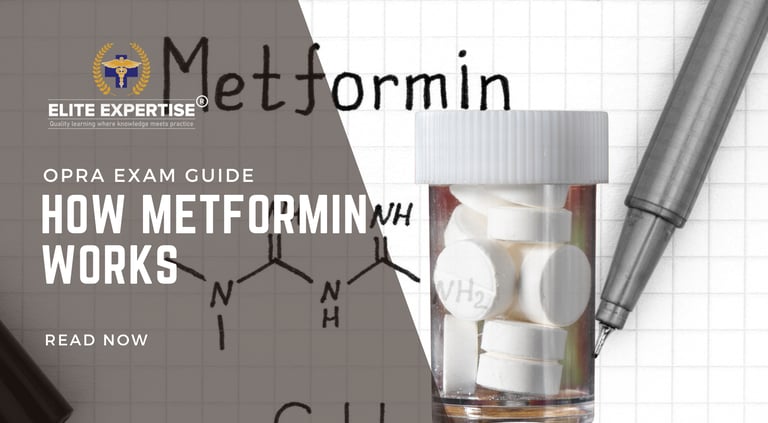ASK MY PHARMACIST | GOT QUESTIONS? Your pharmacist has answers. Click Here
How Metformin Works: OPRA Exam Guide 2025 for Pharmacy Students
Explore liver, mitochondrial, gut and transporter pathways with safety considerations and student-focused study guidance. And understand Metformin’s mechanism of action for the OPRA 2025 exam.
Aditi
10/13/20256 min read


Key Points for Exams
Primary effect: lower hepatic gluconeogenesis
Mitochondrial inhibition (Complex I) → ↑ AMP: ATP → AMPK
mGPD inhibition & redox shift (AMPK-independent)
Inhibits glucagon action → cAMP → PKA pathway
Enhances muscle/fat GLUT4 translocation
Intestinal processes: GLP-1, absorption, neural pathways, microbiome
Dependent on OCT1, OCT2, MATE transporters
Stop in renal failure / acute disease / contrast / surgery
No hypoglycemia risk (as a rule), non-direct insulin secretion
If you’re planning on taking the OPRA 2025 exam, Metformin belongs to the list of medications that you can’t just comprehend at a surface level. Typically, it is thought of as a simple first-line therapy for type 2 diabetes, but actually, its action mechanism is really complicated and involves several pathways that interact. Metformin’s impacts are no less than a jigsaw puzzle whose pieces come from the liver, mitochondria, gut, and different transporters and which are all different. So, students of pharmacy, if you want to achieve the highest score in the exam, then you need to understand every one of these layers. Examiners are no longer satisfied with answers that are mere recitals of buzzwords or over-simplified explanations; instead, they expect clinical insight and reasoning depth from them.
This guide is our way of explaining the mechanisms of Metformin in a simple, well-organised and student-friendly manner. We provide you with a complete picture of how this drug is working in the body and the cells, which includes the use of both AMPK and non-AMPK pathways, its function in peripheral tissues, and the new findings about the effects of the gut. After going through this guide, you will have a profound and clinically applicable understanding of Metformin, which is exactly the kind of understanding that OPRA examiners are seeking.
1. The Liver: Metformin’s Primary Stage
Diabetes Metformin's main target area is the liver, where it reduces glucose production via gluconeogenesis. Due to this effect, the drug is referred to as the first-line treatment of Type 2 diabetes mellitus.
Key steps:
Hepatocytes take up metformin via OCT1 (Organic Cation Transporter 1).
Since it is a positively charged molecule, it is concentrated in the mitochondria.
It passes through the mitochondria, where it blocks the respiratory chain Complex I, thus lowering ATP production.
The ratio of AMP to ATP is increased, so the energy sensor, AMP-dependent protein kinase (AMPK), is activated.
Once AMPK is activated, it suppresses the expression of gluconeogenic enzymes such as PEPCK and G6Pase, diminishes lipid synthesis, and makes the liver more insulin sensitive.
This is the conventional mechanism, but the OPRA examiners now expect you to provide a more detailed explanation.
That is the classic pathway, but OPRA examiners now expect you to go deeper.
2. The Redox & mGPD Pathway — Beyond AMPK
One of the complex machinery that you should learn to handle is:
Metformin blocks the mitochondrial glycerol phosphate dehydrogenase (mGPD) activity.
Due to the blockage of GPD, there is a raised NADH:NAD⁺ ratio which has an inhibitory effect on gluconeogenesis from such intermediates as lactate and glycerol.
The effect in question is AMPK-independent; thus, the redox change will still inhibit glucose production, irrespective of whether AMPK is in charge or not.
A few scientists are looking into Complex IV as part of the picture; however, for the most part, mGPD and the redox shift will be the key elements you should focus on when preparing for the exam.
3. Silencing Glucagon’s Call
Metformin also affects the response of the liver to glucagon:
It lowers cAMP levels in the liver, thus inhibiting PKA activation.
As glucagon uses cAMP → PKA to initiate gluconeogenesis, the interference impelling the liver "to overlook" glucose production signals.
Such a process clarifies the reason why Metformin is seldom accompanied by hypoglycemia - it is not an insulin amplifier but a signal attenuator of the glucagon pathway.
4. Peripheral Tissues: Muscle & Fat
Metformin works beyond the liver:
While in the muscle and fat tissue, the AMPK activation supports the translocation of GLUT4 to the membrane of the cell.
Since more GLUT4 transporters are available on the surface, glucose uptake from the bloodstream is increased.
Most importantly, it achieves this while not causing the release of insulin, thus the danger of low blood sugar remains minimal.
Therefore, while we frequently focus on the liver, the extent of the medication’s positive effect entails both the reduction of production and the facilitation of usage.
5. The Gut: A Rising Star in Mechanism
One of the newer angles suitable for an exam: Metformin's gut-centric actions. Examiners of the OPRA test can't get enough of "extra credit" depth, so you really shouldn't miss this.
What it does in the gut:
Stimulates GLP-1 secretion from gut L-cells → small insulin co-powering, appetite control.
It slows intestinal glucose absorption via the reduction of glucose peaks in the blood after meals
Activate a gut-brain-liver neural circuit which is the source of the signal to the liver to decrease glucose output
Changes microbiome composition that may be a source of metabolic benefits as well as gastrointestinal side effects.
Extended-release Metformin variants, which concentrate their activity in the gastrointestinal tract (with only a small amount going into the blood), give almost the same result, meaning that the effect of the gut may be just as important as that of the liver.
6. Transporters & Distribution
If you are looking for examiner points, then you can not ignore transporters.
OCT1: Transport of the drug to the liver—changes in this area will impact the drug effect.
OCT2 (kidney uptake) and MATE1/MATE2-K (renal efflux) are the main sources of elimination.
Reduced function of renal transporters or the kidney will cause drug build-up and the risk of adverse effects will increase.
While you are preparing for your exams, you should always connect the process with actual patient risk.
7. Safety: Lactic Acidosis & High-Stakes Moments
Although Metformin-Associated Lactic Acidosis (MALA) is an infrequent cause, it is still the major warning.
Mechanism behind risk:
Metformin limits cell respiration in mitochondria which leads the cells to anaerobic glycolysis, a less efficient pathway and, thus, more lactate is formed.
When lactate removal (particularly from the kidney) is hindered, lactate accumulates.
Situations such as serious infection, lack of oxygen, kidney failure, heart failure, surgery, or the use of iodinated contrast increase the risk.
Exam tip: When safety is in question, be sure to always give the advice “stop in acute illness/renal failure/ before contrast/ surgery.”
8. Study Strategy & How Coaching Helps
This medication is a high-yield test topic; however, it is complex and it is quite simple to make an overgeneralization. Here are some tips for efficient studying of this topic:
Sketch the mechanism (liver, redox, gut).
Use your flashcards for the safety rules and transporters.
Practice Multiple Choice Questions that involve mechanisms (e.g. "what happens if OCT1 polymorphism?")
Review cases that require the knowledge of Metformin's side effects or contraindications.
How coaching (e.g. via Elite Expertise’s OPRA Exam Preparation Course) can boost you:
The OPRA coaching by Elite Expertise comes with a well-planned structure including:
Online classes, written notes
Practice tests and assignments.
Guidance by the mentor, 24/7 help and a WhatsApp group.
Train-the-trainer program for experts with actual pharmacy practice.
Responsible coaching will help you keep up your pace if you happen to be managing self-study, tiredness, or not fully understanding the subject matter. Also, it will help you find those difficult topics that you have overlooked.
Final Word
Metformin can't be defined only by "AMPK and glucose-lowering". To succeed at OPRA 2025, you should be able to tell about its combined hepatic + gut roles, talk about redox/mGPD changes, give a short explanation of transporters, and most importantly, make a connection between the drug and clinical safety all the time.
If you are totally confused about how to combine various aspects and still move forward, a coaching program like Elite Expertise could really take your preparation to another level. By working with the proper guidance, having your plan and putting your skills to practice, you will go beyond your Metformin cramming and really master it.
Wishing you all the best with your OPRA preparation! We are ready to help you with the next task if you need this content transformed into slides, MCQ sets, or a video script.
This blog is intended for educational purposes only and is designed to support students preparing for the OPRA exam. The information provided does not replace official exam materials, clinical judgment, or professional medical advice. Elite Expertise is an independent educational institution and is not affiliated with the Australian Pharmacy Council or any official regulatory body
⚠️ Disclaimer


About the Author
Aditi Pathak
Content Writer | Elite Expertise
Aditi Pathak is an experienced SEO content writer with over 4 years of expertise in crafting engaging, well-researched, and search engine–optimized content. Currently pursuing her Master’s in English, she brings together strong academic knowledge and creative writing skills to deliver blogs and articles that are both informative and reader-friendly. Aditi is passionate about simplifying complex topics into clear, accessible content that resonates with diverse audiences. Her focus lies in creating value-driven content strategies that enhance online visibility while keeping readers informed and engaged.
Follow On
Follow Us
+91 76750 84909
Privacy Policy | © 2025 Elite Expertise . All Rights Reserved.
ELITE EXPERTISE PTY. LTD (ABN: 15668292439) (ACN: 668292439)
Australian Statutory Education License: OPP 2025 ELITE EXPERTISE PTY. LTD
Disclaimer
Elite Expertise is an online education platform dedicated solely to providing coaching and preparation services for the OPRA, PEBC, PSI and PTE exams. We do not offer any sponsorship or migration services. All information provided on our platform is for educational purposes only and should not be interpreted as legal or immigration advice. For inquiries regarding sponsorship, visa applications, or migration services, please consult with licensed immigration professionals or relevant authorities.
Elite Expertise is a trusted and results-driven training platform specializing in preparation for international pharmacist licensing exams. Our comprehensive courses, expert instructors, and proven methodologies have helped countless pharmacy professionals achieve their goals and succeed in competitive regulatory exams. We are proud of our strong success rate and commitment to excellence.
Elite Expertise is an independent training provider. We are not affiliated with any global pharmacy regulatory authorities or official exam-conducting bodies.
Copyright © 2025 Elite Expertise. All rights reserved.
Address
Unit 1/73 Beverley St, Doncaster East VIC 3109, Australia
